Yesterday I reported on the status of the ‘nest B’ Red-tailed Hawk fledglings. Today I’ll provide an update on the fledglings from nearby nest A.
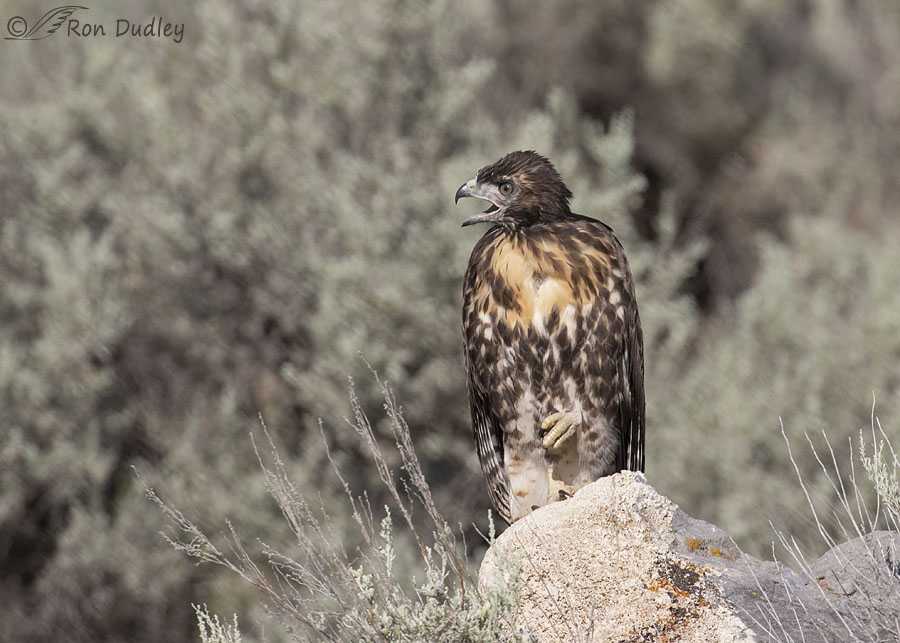
1/3200, f/6.3, ISO 640, Canon 7D Mark II, Canon EF 100-400mm f/4.5-5.6L IS II USM @ 400mm, not baited, set up or called in
The last time I visited nest A the nest was empty and I couldn’t find any of the chicks or adults nearby but two days ago I found this lone fledgling very close to the nest. Fairly soon after the eggs hatched I could see three tiny white bobbleheads in the nest but a few weeks later only two had survived.
First some bad news. Soon after I took this photo I had a short visit with a woman along the dirt road who was monitoring raptor nests for RINS (Raptor Inventory Nest Survey). She told me that the second fledgling from this nest had died. I won’t go into the gory details but it was a natural death. She didn’t say how she knew this but since she works for RINS and is presumably a trained observer I believe it’s probably accurate information.
But thankfully this last youngster seemed like ‘he’ was doing just fine. He’s a little younger than the two fledglings from nest B just up the road and here he was calling loudly, presumably for food to be delivered from one of his parents. I never saw either of his parents that morning but I didn’t spend much time in the vicinity of this nest.
At this age fledglings are still learning to do just about everything, including but not limited to the intricacies of takeoffs, landings and flight. When they attempt something fairly new to them they go at it enthusiastically, fearlessly and usually clumsily which can be quite amusing and even endearing for the human observer.
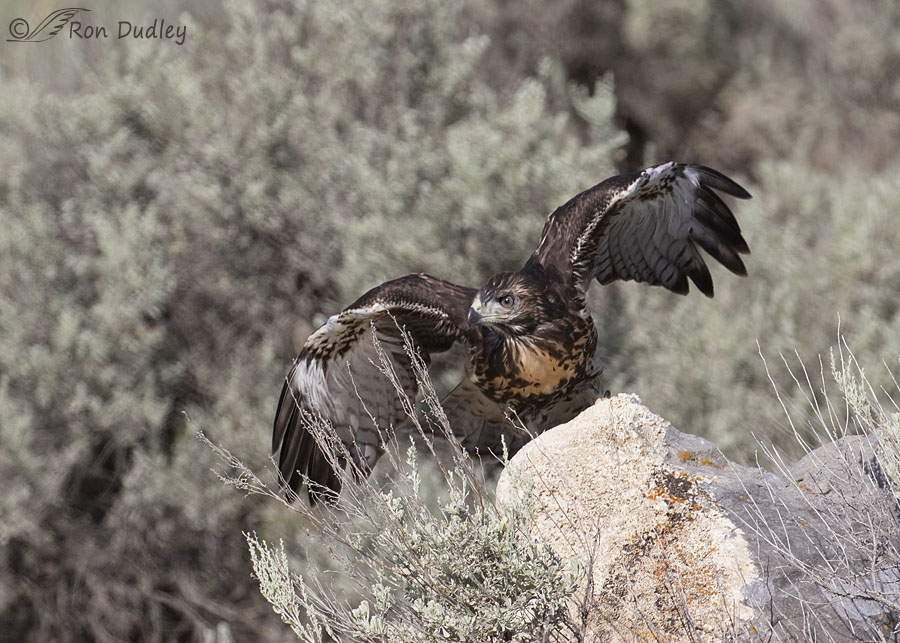
1/3200, f/6.3, ISO 640, Canon 7D Mark II, Canon EF 100-400mm f/4.5-5.6L IS II USM @ 278mm, not baited, set up or called in
This fledgling’s takeoff was an example. He crouched down and opened his wings just prior to pushing off with his legs. So far pretty good technique, especially for such a young bird.
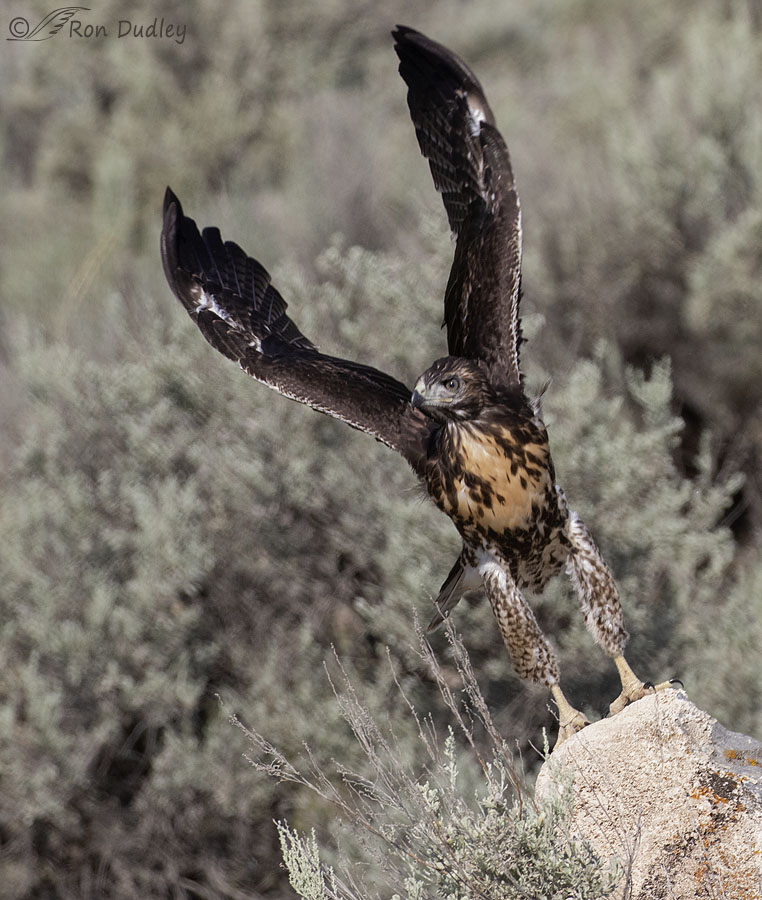
1/3200, f/6.3, ISO 640, Canon 7D Mark II, Canon EF 100-400mm f/4.5-5.6L IS II USM @ 278mm, not baited, set up or called in
But his push-off angle to the vertical was very close to straight up rather than forward and up so his push-off provided little if any acceleration or momentum in the direction he meant to go (which obviously wasn’t straight up).
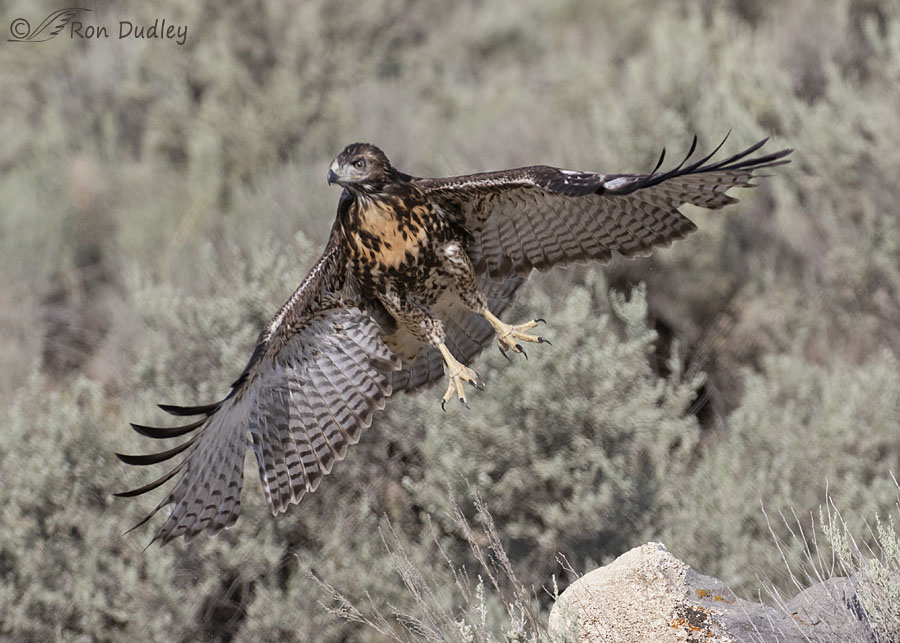
1/3200, f/6.3, ISO 640, Canon 7D Mark II, Canon EF 100-400mm f/4.5-5.6L IS II USM @ 278mm, not baited, set up or called in
So immediately after takeoff he had no forward momentum to speak of to provide lift so the only lift available to him had to be provided by flapping. For a moment or two I thought he was going to fall right out of the sky. Because of his unexpected vertical takeoff this is the last shot I got without amputating body parts.
I have to wonder if his awkwardness isn’t in some way responsible for his several lost or broken flight feathers.
I adore those last two shots for his obvious enthusiasm and awkwardness at takeoff. In both photos those stiff vertical legs, and splayed feet in the second shot, tickle my funny bone.
Ron
PS – I have another photo taken that same morning of one of the youngsters from nest B that I wish I’d thought to include in yesterday’s post so I’m tacking it on to the end of today’s.
While they’re in their nest red-tail chicks shoot their wastes over the edge of the nest for sanitary reasons. It’s an instinctive behavior and they put great effort into squirting it far enough without falling off the edge of the nest.
1/2000, f/6.3, ISO 640, Canon 7D Mark II, Canon EF 100-400mm f/4.5-5.6L IS II USM @ 400mm, not baited, set up or called in
That instinct remains with them after fledging. This young bird put all he had into shooting that nasty stuff far away. I don’t post poop shots often, in part because I think birds deserve their privacy and dignity at such moments but I enjoyed this one so much I decided to make an exception
Falconers call this “slicing” and adult raptors do it too. When I was teaching I’d often have education raptors brought into class and they would reliably foul my blackboards (later my whiteboards) some distance behind them.
Thankfully I had classroom aides to clean it up…


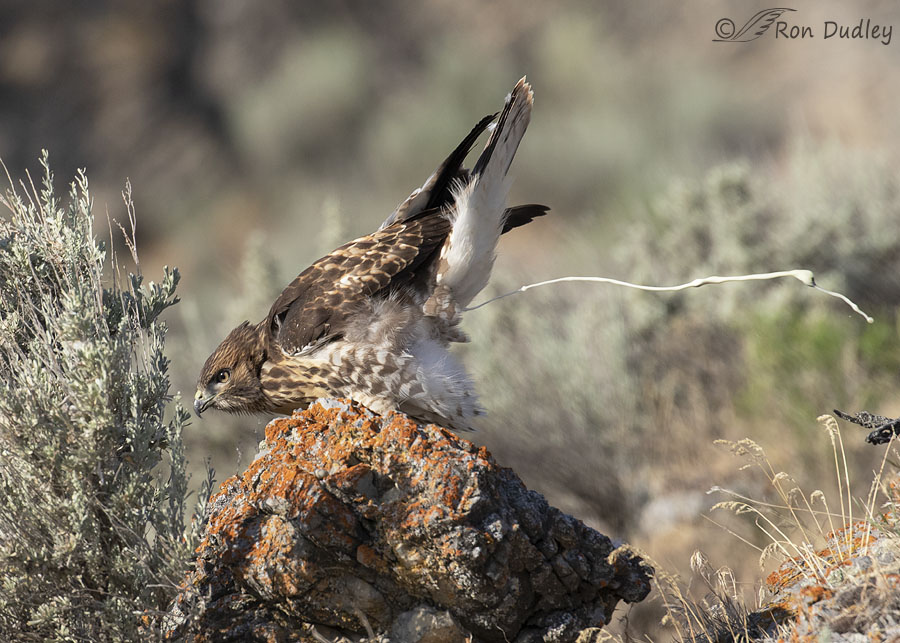
Delightful series of photos. You always brighten my day, Ron.
Well, shit happens and you’re just documenting, right? I’ll admit that I’m also a little more entertained by that last shot than I should be, but man, that is going for distance! As for making your TAs clean up after the visiting raptors, that’s dirty pool (or should I say, dirty poo!). I always cleaned up after the animals — visiting or classroom — unless a kid really wanted to help, which was about at hen’s teeth frequency.
I’ll admit that I’m also a little more entertained by that last shot than I should be, but man, that is going for distance! As for making your TAs clean up after the visiting raptors, that’s dirty pool (or should I say, dirty poo!). I always cleaned up after the animals — visiting or classroom — unless a kid really wanted to help, which was about at hen’s teeth frequency.
Sad that only one youngster is left from A and thank you for sparing us the details. Mother Nature’s a tough mistress. Hopefully, this one will get its flying act together and have a successful life. I love the “wing fling” shot, as always!
“As for making your TAs clean up after the visiting raptors, that’s dirty pool ”
Marty, in situations like that my motto is… rank has its privileges.
Britches!!! (And yes, I noted those painted ‘toe-nails’ too).
I strongly suspect that this ‘ungainly’ youngster’s flight attempt was considerably more gainly than my first attempt at walking – which he/she nailed much faster than I did before going on to higher things.
I am impressed at the ‘toilet’ control as well. Yet another thing that they learn quicker than we do.
Thank you Ron.
Thanks, EC. I hope today is going better for you than yesterday did.
“Wings Up!” This one hasn’t yet fully developed that “baby giraffe” pattern on his/her legs but it’s coming! And “Failure to Launch” is priceless! Great images, Ron … just sorry there aren’t at least 2 of them to share the glories and ignominies of growing up hawk. Will hold a good thought for this little one to beat the odds.
(P.S. — That PS shot is a winner!)
“just sorry there aren’t at least 2 of them”
Me too, Chris. If I remember correctly there were 5 red-tails successfully fledged out of two nests in that area last year. This year there were only 3.
Photo #1: You at least might have tried blowing hard towards him to give him some headwind and lift. I mean, a little help here, please. On the other hand that might have made him do a backassward plant in the sagebrush.
Photo #2: All those years of experience to learn just the right exposure settings for this.
Teaches me never to sneak up behind a raptor. Not without a telephoto lens.
Your last words are wise ones, Lyle. You just never know when they’re going to let’er rip.
That’s a lot of poop! This is quite the beautiful bird, pantaloons and black goth toenails included. He does look like a survivor…lets hope for a long life for him! Speaking of incessant calling of fledglings to be fed…yesterday I had a fledgling oriole that clung to the top of one of my feeding stations with a constant chirp, chirp, chirp. No one respond to him all morning…there were dozens flying in but none apparently was a parent. I was getting worried come afternoon thinking perhaps something had happened to them. He would fly down to the jelly and ruffle and chirp whenever one flew in but nada. He did not help himself either! Finally about 2 o’clock one started feeding him… perhaps trying to teach him how to feed himself. I was glad for the chirping to stop!
This is quite the beautiful bird, pantaloons and black goth toenails included. He does look like a survivor…lets hope for a long life for him! Speaking of incessant calling of fledglings to be fed…yesterday I had a fledgling oriole that clung to the top of one of my feeding stations with a constant chirp, chirp, chirp. No one respond to him all morning…there were dozens flying in but none apparently was a parent. I was getting worried come afternoon thinking perhaps something had happened to them. He would fly down to the jelly and ruffle and chirp whenever one flew in but nada. He did not help himself either! Finally about 2 o’clock one started feeding him… perhaps trying to teach him how to feed himself. I was glad for the chirping to stop!
Kathy, you have “dozens” of orioles! I’m so jealous. Some years ago I had a few that would occasionally come to my feeder but not any more.
Last year we put out 37 large jars of Smucker’s and Welch’s grape jelly and jam. We have two robins, a pair of catbirds and 3 RedBellied woodpeckers that frequent the jam stations this year…they go from jam to suet.
There’s a Redtail nest in our next-door neighbor’s tree and there are 3 fledgings that are out and about occasionally now but still returning to the nest. The squawking is intense. I love seeing your close-up shots of these and the others as I don’t get that close to “ours.” Oh and a few days ago there were two fledging Great Horned Owls flying around. Bad news for the bunnies and voles but great fun for us bird lovers.
You’re lucky to have a nest so close, Linda. I hate to admit how far I have to drive for these two nests.
Again, YAY! YEE HAW!! YIPPEE! Time to celebrate survival because it ain’t as easy as it looks, is it? What a BEAUTIFUL baby–and yes, I’m easy on redtails! Yeah, baby hawks are clumsy in the beginning just after fledging. Just like us learning to walk, they’re not all that clear how all the controls work, but they learn it pretty quickly! First comes the flight controls then putting it all together to chase running prey. You can trust me on this. It’s NOT unusual for them to slice six feet (and bonus points are seemingly awarded if you can hit the falconer’s face/head and/or the bath pan). The slice concept comes from the Middle English/Dutch sluice, meaning a flood gate, assuming your readers are curious about the derivation. As a falconer, you learn to recognize when it’s coming and you get a three- to five-second warning before the actual slice arrives. You also learn how to catch it in your right hand if you’re in the hotel at a meet/gathering. When doing classroom programs I always tried to factor that into the placement of the floor sheets. LOL! But the poops ALWAYS keep kids entertained.
You can trust me on this. It’s NOT unusual for them to slice six feet (and bonus points are seemingly awarded if you can hit the falconer’s face/head and/or the bath pan). The slice concept comes from the Middle English/Dutch sluice, meaning a flood gate, assuming your readers are curious about the derivation. As a falconer, you learn to recognize when it’s coming and you get a three- to five-second warning before the actual slice arrives. You also learn how to catch it in your right hand if you’re in the hotel at a meet/gathering. When doing classroom programs I always tried to factor that into the placement of the floor sheets. LOL! But the poops ALWAYS keep kids entertained.
Redtails are championship poopers
Conversely, falcons are much more polite. They poop straight downward so the mess is far more easily contained. Harris’ hawks are somewhere in between. THERE! Now you’re ready for Who Wants to be a Millionaire! You’re welcome
I LOVE redtails (and Harris’hawks and Kestrels, and oh never mind–raptors/birds/critters!)!
Interesting (and logical) derivation, Laura.
Now, catching it in my hand is something I never tried. I should have made that an assignment for my aides but I’m sure they would have revolted. And been revolted…
HEHEHE, it’s warm and slimy, but better in your hand than down your neck or in your face. Again, you can trust me on this
What a lot of personality this little guy manages to display…..;loved your
classroom tales–I’ll bet the students absolutely LOVED those “shooters”
and are telling their children ( and maybe now grandchildren ? ) about
the wonderful biology classes they were treated to– can’t do THAT with
a virtual classroom !
Good point about virtual classrooms, Kris. I feel so very sorry for both students and teachers these days.
Neat behaviors, kind of like youngsters just starting to walk. Interesting photos and information. I have had eagles shoot right at me while I’m taking photos, but fortunately I have been far enough away.
Thank you, Everett.
The poop shooting out of the poop chute entertained me far more than it should have. Lol.
If pinned down I’d have to admit the same thing, Arwen.
Pantaloons, splayed feet, and poop shots. This was a very entertaining (and educational) post, even before you got to the classroom aides.
I’m glad you enjoyed it, Cathy. Thanks.
Glad at least one chick has survived. Intellectually I know they can’t or we’d be over run but emotionally it still tugs at my heart strings……. Watching the young of anything “learn” IS amusing! “Shooting” is certainly something I wouldn’t want to be in the line of fire for!
Watching the young of anything “learn” IS amusing! “Shooting” is certainly something I wouldn’t want to be in the line of fire for!  Adaptations are endless in nature.
Adaptations are endless in nature.
“Shooting” is certainly something I wouldn’t want to be in the line of fire for!”
Judy, at least twice over the years one of my classroom aides forgot about that little bit of sage advice. Both times they were girls and both times it was absolutely hilarious!
Can only imagine!